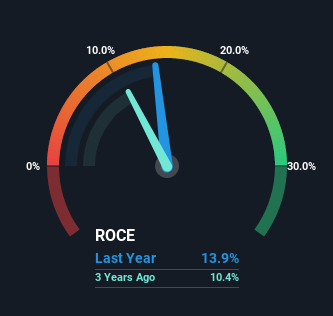- India
- /
- Auto Components
- /
- NSEI:STERTOOLS
Capital Allocation Trends At Sterling Tools (NSE:STERTOOLS) Aren't Ideal
To find a multi-bagger stock, what are the underlying trends we should look for in a business? Ideally, a business will show two trends; firstly a growing return on capital employed (ROCE) and secondly, an increasing amount of capital employed. Ultimately, this demonstrates that it's a business that is reinvesting profits at increasing rates of return. Although, when we looked at Sterling Tools (NSE:STERTOOLS), it didn't seem to tick all of these boxes.
Return On Capital Employed (ROCE): What Is It?
For those that aren't sure what ROCE is, it measures the amount of pre-tax profits a company can generate from the capital employed in its business. The formula for this calculation on Sterling Tools is:
Return on Capital Employed = Earnings Before Interest and Tax (EBIT) ÷ (Total Assets - Current Liabilities)
0.14 = ₹619m ÷ (₹5.9b - ₹1.5b) (Based on the trailing twelve months to December 2022).
So, Sterling Tools has an ROCE of 14%. By itself that's a normal return on capital and it's in line with the industry's average returns of 14%.
View our latest analysis for Sterling Tools

Historical performance is a great place to start when researching a stock so above you can see the gauge for Sterling Tools' ROCE against it's prior returns. If you'd like to look at how Sterling Tools has performed in the past in other metrics, you can view this free graph of past earnings, revenue and cash flow.
SWOT Analysis for Sterling Tools
- Earnings growth over the past year exceeded the industry.
- Debt is not viewed as a risk.
- Dividend is low compared to the top 25% of dividend payers in the Auto Components market.
- Current share price is above our estimate of fair value.
- STERTOOLS' financial characteristics indicate limited near-term opportunities for shareholders.
- Lack of analyst coverage makes it difficult to determine STERTOOLS' earnings prospects.
- Paying a dividend but company has no free cash flows.
What The Trend Of ROCE Can Tell Us
When we looked at the ROCE trend at Sterling Tools, we didn't gain much confidence. Over the last five years, returns on capital have decreased to 14% from 28% five years ago. However, given capital employed and revenue have both increased it appears that the business is currently pursuing growth, at the consequence of short term returns. And if the increased capital generates additional returns, the business, and thus shareholders, will benefit in the long run.
What We Can Learn From Sterling Tools' ROCE
In summary, despite lower returns in the short term, we're encouraged to see that Sterling Tools is reinvesting for growth and has higher sales as a result. In light of this, the stock has only gained 14% over the last five years. So this stock may still be an appealing investment opportunity, if other fundamentals prove to be sound.
If you'd like to know more about Sterling Tools, we've spotted 2 warning signs, and 1 of them is a bit concerning.
While Sterling Tools isn't earning the highest return, check out this free list of companies that are earning high returns on equity with solid balance sheets.
New: Manage All Your Stock Portfolios in One Place
We've created the ultimate portfolio companion for stock investors, and it's free.
• Connect an unlimited number of Portfolios and see your total in one currency
• Be alerted to new Warning Signs or Risks via email or mobile
• Track the Fair Value of your stocks
Have feedback on this article? Concerned about the content? Get in touch with us directly. Alternatively, email editorial-team (at) simplywallst.com.
This article by Simply Wall St is general in nature. We provide commentary based on historical data and analyst forecasts only using an unbiased methodology and our articles are not intended to be financial advice. It does not constitute a recommendation to buy or sell any stock, and does not take account of your objectives, or your financial situation. We aim to bring you long-term focused analysis driven by fundamental data. Note that our analysis may not factor in the latest price-sensitive company announcements or qualitative material. Simply Wall St has no position in any stocks mentioned.
About NSEI:STERTOOLS
Sterling Tools
Manufactures and sells high tensile cold forged fasteners to original equipment manufacturers in India.
Flawless balance sheet, good value and pays a dividend.
Similar Companies
Market Insights
Community Narratives



